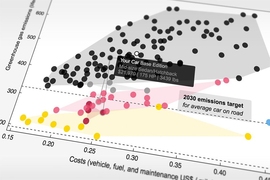The dramatic drop in the cost of solar photovoltaic (PV) modules, which has fallen by 99 percent over the last four decades, is often touted as a major success story for renewable energy technology. But one question has never been fully addressed: What exactly accounts for that stunning drop?
A new analysis by MIT researchers has pinpointed what caused the savings, including the policies and technology changes that mattered most. For example, they found that government policy to help grow markets around the world played a critical role in reducing this technology’s costs. At the device level, the dominant factor was an increase in “conversion efficiency,” or the amount of power generated from a given amount of sunlight.
The insights can help to inform future policies and evaluate whether similar improvements can be achieved in other technologies. The findings are being reported today in the journal Energy Policy, in a paper by MIT Associate Professor Jessika Trancik, postdoc Goksin Kavlak, and research scientist James McNerney.
The team looked at the technology-level (“low-level”) factors that have affected cost by changing the modules and manufacturing process. Solar cell technology has improved greatly; for example, the cells have become much more efficient at converting sunlight to electricity. Factors like this, Trancik explains, fall in a category of low-level mechanisms that deal with the physical products themselves.
The team also estimated the cost impacts of “high-level” mechanisms, including learning by doing, research and development, and economies of scale. Examples include the way improved production processes have cut the number of defective cells produced and thus improved yields, and the fact that much larger factories have led to significant economies of scale.
The study, which covered the years 1980 to 2012 (during which module costs fell by 97 percent), found that there were six low-level factors that accounted for more than 10 percent each of the overall drop in costs, and four of those factors accounted for at least 15 percent each. The results point to “the importance of having many different ‘knobs’ to turn, to achieve a steady decline in cost,” Trancik says. The more different opportunities there are to reduce costs, the less likely it is that they will be exhausted quickly.
The relative importance of the factors has changed over time, the study shows. In earlier years, research and development was the dominant cost-reducing high-level mechanism, through improvements to the devices themselves and to manufacturing methods. For about the last decade, however, the largest single high-level factor in the continuing cost decline has been economies of scale, as solar-cell and module manufacturing plants have become ever larger.
“This raises the question of which factors can help continue the cost decline,” Trancik says. “What are the limits to the size of the plants?”
In terms of government policy, Trancik says, policies that stimulated market growth accounted for about 60 percent of the overall cost decline, so “that played an important part in reducing costs.” Policies stimulating market growth globally included measures such as renewable portfolio standards, feed-in tariffs, and a variety of subsidies. Government-funded research and development in various nations accounted for roughly 30 percent — although public R&D played a larger part in the earlier years, she says.
This is important information, she adds, because “for a long time there has been a debate about whether these policies work — were they really driving technological improvement? Now, we can not only answer that question, we can say by how much.”
This finding, which is based on modeling device-level mechanisms rather than purely correlational analysis, provides strong evidence of a “virtuous cycle” that can be created between technology innovation and policies to reduce emissions, Trancik says. As emissions policies are implemented, low-carbon technology markets grow, technologies improve, and the costs of future emissions reductions can decline. “This analysis helps us understand why this happens, and how strong the feedbacks can be.”
Trancik and her co-workers plan to apply similar methodology to analyzing other technologies, such as nuclear power, as well as the other parts of solar installations — the so-called balance of systems, including the mounting structures and power controllers needed for the solar modules — which were not included in this study. “The method we developed can be used as a tool to assess costs of different technologies, both retrospectively and prospectively,” Kavlak says.
“This opens up a different way of modeling technological change, from the device level all the way up to policy measures, and everything in between,” Trancik says. “We’re opening up the black box of technological innovation.”
“Going forward, we can improve our intuition about what factors in general make technologies improve quickly. The application of this tool to solar PV is just the beginning of what we can do,” McNerney says.
While the study focused on past performance, the factors it identified suggest that “it does look like there are opportunities for further cost improvements with this technology.” The findings also suggest that researchers should continue working on alternative technologies to crystalline silicon, which is the dominant form of solar photovoltaic technology today, but many other varieties are being actively explored with potentially higher efficiencies or lower materials costs.
The study also highlights the importance of continuing the progress in improving the efficiency of the manufacturing systems, whose role in driving down costs has been important. “There are likely more gains to be had in this direction,” Trancik says.
Gregory Nemet, a professor of public affairs at the University of Wisconsin at Madison, who was not involved in the study, says, “This work is important in that it identifies that the growth in demand for solar PV in the past 15 years was the most important driver of the astounding cost reductions over that period. Policies in Japan, Germany, Spain, California, and China drove the growth of the market and created opportunities for automation, scale, and learning by doing.”
Nemet adds, “Their model is simple and general, which could make it useful for designing policies for other technologies that will be needed to address climate change and other energy-related problems.”
The research was supported by the U.S. Department of Energy.











